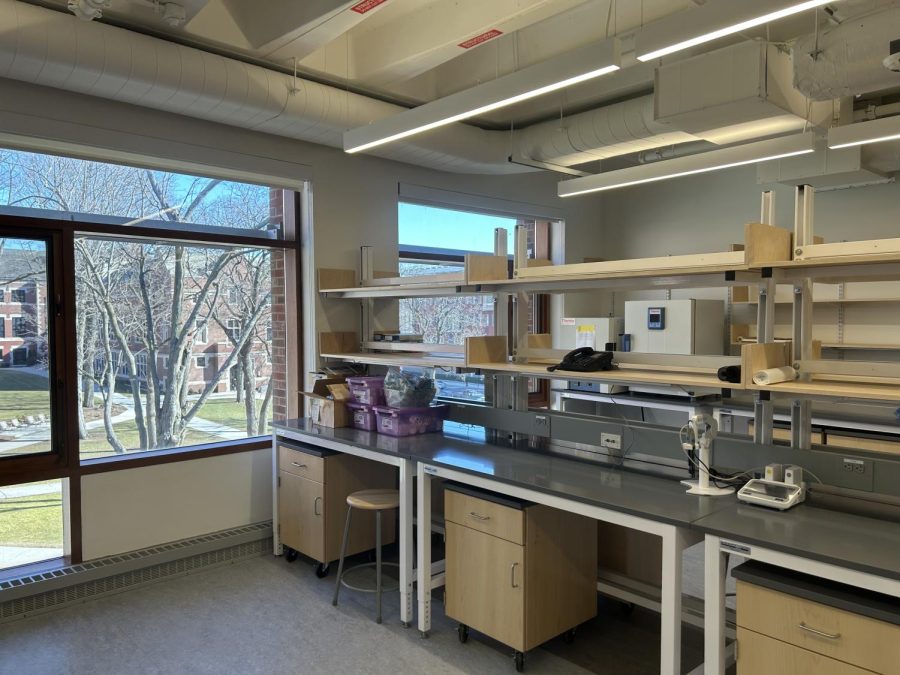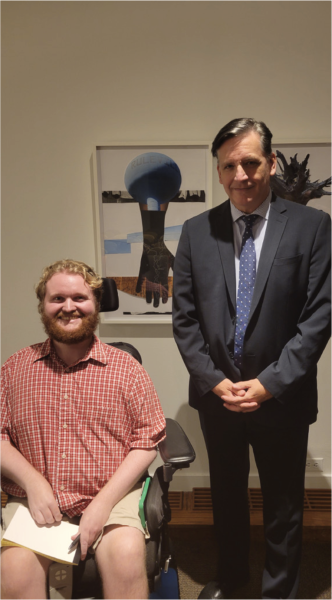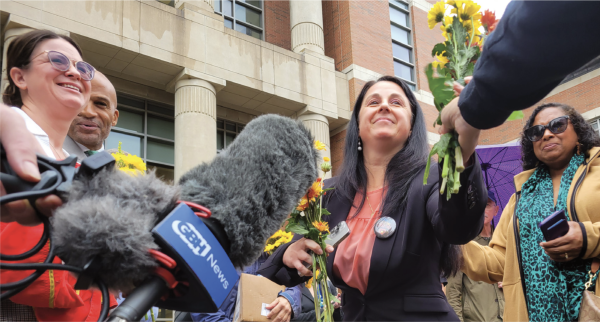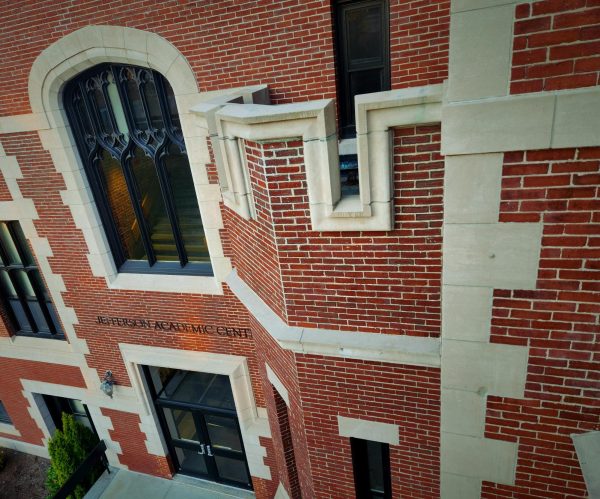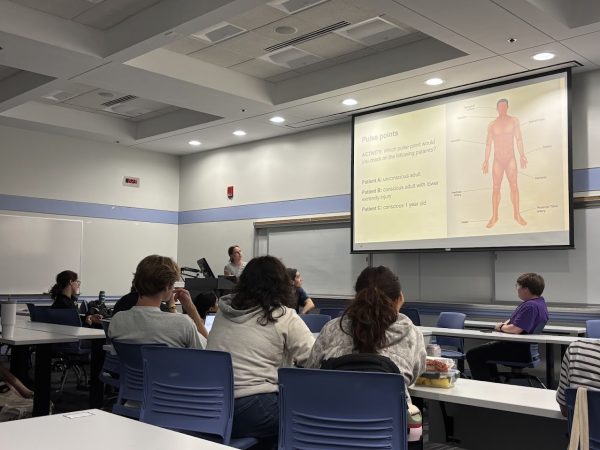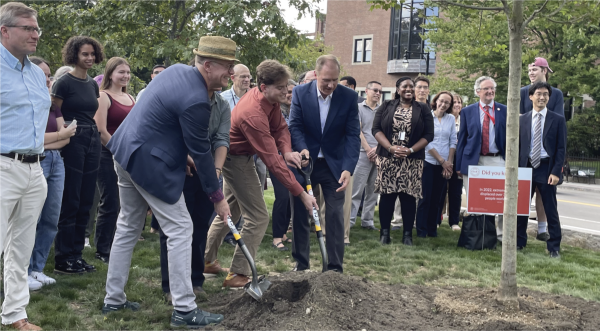School of Geography Opens New Laboratories, With Little Fanfare
The view of Red Square from Dr. Karen Frey’s new lab.
On the third floor of the Sackler Sciences Center, there is a wing that looks very much out of place. It hardly matches its surroundings, with soft LED fittings, colorful wall paneling, and shiny state-of-the-art equipment.
This brand new facility, an entirely refurbished floor which the Carlson Science Library once occupied, opened quietly at the start of this semester. Faculty of the Graduate School of Geography have slowly begun to occupy the space.
That wing of the Sackler Center had already been emptied, as the Science Library had been closed and consolidated into the main branch of the Goddard Library.
The redesign was holistic, including new common rooms, a conference room, a kitchenette, and five offices. Then there’s the big draw: full-sized “dry” and “wet” laboratories.
The dry lab belongs to Dr. Christopher Williams, while the wet lab is occupied by Dr. Karen Frey. Both are professors in the School of Geography.
The cause for the move began in the Department of Biology, which recently added new faculty members in need of lab space. Williams and Frey had previously occupied labs in the Lasry Center for Bioscience. When a need for change was identified, the university stepped in to make the refurbishment happen.
“We’ve been working in spaces that weren’t really designed for what we need,” Williams explained in an interview. More than a year ago, he said, a team of administrators and faculty organized a plan to retrofit the former library to suit the needs of the School of Geography. That team included the University’s Chief of Staff, the Dean of Research and executives from Facilities Management and the Space Committee, a group charged with overseeing and assigning academic space on campus.
Architects hired by the university to design the space sought input from Williams and Frey in order to design facilities better suited to the particular needs of their research.
“It was a fantastic process, and the outcome was really great,” Frey told The Scarlet. “All the staff and administration on campus have been really incredibly helpful in getting this process to where we are now.”
Neither Williams nor Frey were informed of how much the university spent on the renovations, or where the funds came from.
The project had been delayed by several months, mostly due to pandemic-related supply chain issues. “We were supposed to move in in July [of 2022,] but it just wasn’t a feasible timeline,” Williams said. The final holdup, he said, was for a fume hood part.
Williams said he sympathized with the new biology faculty who had to wait for space in the Lasry Center to open up. “That’s tough when you’re waiting, especially when you’re doing research,” he said.
Still, even with all the delays, “it was actually pretty quick when you consider how significant the renovation is,” Williams said.
Labs Purpose-Built for Climate Research
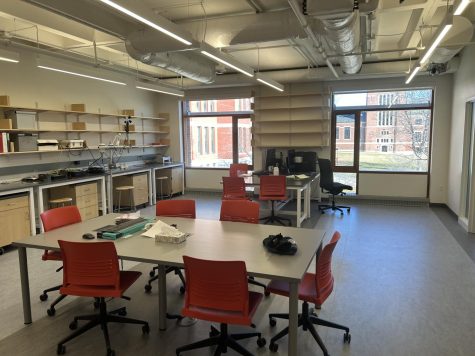
The new dry lab has several functions, Williams explained. A significant amount of space is allocated for supercomputing – desktop towers that run geographic information system (GIS) calculations. The lab also acts as a staging and storage area for field equipment.
“What we do in my lab,” Williams said, is “measure surface-atmosphere exchanges of carbon dioxide, water vapor, and momentum,” using deployable field tools, such as eddy covariance towers. Those equipment can also measure the health of a forest, tracking important biological factors like photosynthesis and evapotranspiration, all the way down to the scale of a leaf.
Williams, presently on sabbatical, had used the field measurement tools over seven years for a project funded by the National Science Foundation at Harvard Forest, a managed ecological study area in Petersham, Mass.
In his search for a new project, Williams is considering finding a place to set up a tower on Clark’s campus. “In the meantime, I’m going to have it deployed here in the lab as a place to tinker and show people what we do,” he said.
In his lab, Williams works with both undergraduate and graduate level students. He collaborates with research scientists, too, like Dr. Natalia Hassler.
Hassler uses the lab’s supercomputers for her two research projects, both of which are with the Nature Conservancy, regarding the use of reforestation as a climate solution.
“Let’s say you reforest a grassland to a forest – your albedo (reflectivity of the land surface) is going to get darker, and that is going to usually have a warming global climate effect,” Hassler said. “That will sort of offset the carbon sequestration from the forest. A lot of times, that albedo effect has been ignored,” she said.
“So, in a lot of places around the globe where we have reforestation projects, it might not be such a good idea, climate-wise,” Hassler explained. In the two projects, she analyzes GIS data at two levels – in the U.S. and at a global scale – in order to determine how best to use forest management as a strategy to slow the effects of climate change, and not hasten them.
Next door, in Dr. Frey’s lab, climate research is even more hands-on. “My lab is a little bit different,” Frey said, because “it’s a proper wet lab where we have a clean water source, fume hoods, and we deal with chemicals.” Frey leads the Polar Science Research Laboratory at the School of Geography, whose work necessitates a space that can handle samples brought back from the Arctic.
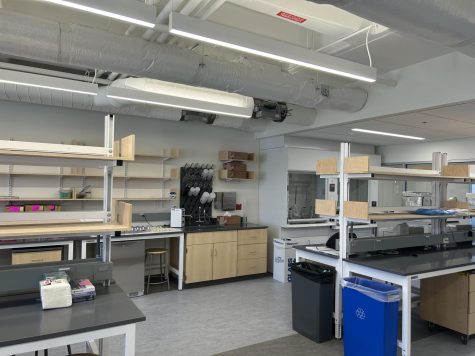
For her research, Frey uses lots of field gear – “a couple thousand pounds that goes off and on campus at least once a year,” she explained. In the summer, that equipment gets shipped off to the West Coast and transported by ice breaker to the Arctic. When her work is done, all the equipment is loaded up again and moved back to Worcester.
“The challenge with the space in Lasry is that we had very little storage,” Frey said. “Oftentimes, that couple thousand pounds of stuff was just on the floor… it was inconvenient because of that.”
Frey called the increase in storage space in the new lab “revolutionary,” and said that certain new equipment like the two fume hoods, work benches, and fridges and freezers, have not only made the lab safer and more navigable, but also better-equipped for research.
Frey explained that in her work, “we are looking at sea ice that has been melted and filtered and refrozen.” She and her team go in the summer months to collect their samples when there’s no sea ice. They freeze those samples so they can be safely transported back to Clark and studied later.
“We’re generally trying to answer the very basic question of, how are these marine ecosystems responding to declining sea ice?” Frey said. To answer that question, she explained, her team brings home filtered sea water to determine concentrations of chlorophyll and phytoplankton – two hallmarks of primary productivity, the base of the food chain, in Arctic waters.
“Everything starts with photosynthesis, just like on land,” Frey said. From the data she collects, Frey can analyze changes in productivity at all levels of the shallow northern seas – from surface waters, to the water column, to the seafloor.
She sees a special value in phytoplankton analysis, because it “gives you an idea of how the species are changing with climate change, and therefore how what’s going to feed on them is going to change.”
Frey’s big takeaway so far, she said, is that with climate change, “we’re noticing that phytoplankton are becoming smaller, they’re becoming less nutritious, their fat content is decreasing. That works its way up,” she said. As the federal government declares more and more unusual mortality events in marine ecosystems, Frey explained, “you see these animals washing up on the shore and wonder what’s happening.”
“There’s a lot of different hypotheses, but it all seems to stem back to nutrition,” she said. She hopes her work in the lab can help reveal new insights into how these events are connected to climate change, particularly as they start to impact indigenous communities that hunt for subsistence.
Disparities in Lab Facilities Revealed
For his part, Frank Abell was very impressed with the new lab facilities. “It’s really nice – the spaces are open, I love that – all labs should be designed this way now,” he said.
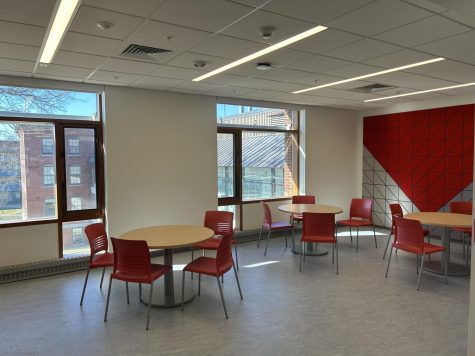
Abell, who serves as the university’s Environmental Health and Safety Officer, and as the Chemistry Laboratory Manager, says he’s seen the best and the worst in facilities in his 20 years at Clark.
In his view, the new geography laboratories rank among the best on campus. Abell’s responsibilities are wide ranging: he’s charged with testing eye washing stations and showers, fume hoods, and more. “Now that it’s a laboratory space, I have to be involved,” said Abell. He said he worked closely with Frey and Williams to get their labs ready for work.
“This is a nice space,” he said. “This is the way I would like my chemistry building to work.”
Abell praised the open floor space of the new facilities, particularly in Dr. Frey’s lab, as compared to other labs in the Sackler Center. In introductory chemistry, “you’re bouncing all over the place,” he lamented. “It’s an unsafe environment, for me. This is safer – there’s plenty of room to move around.”
He said he couldn’t help but feel a little jealous, noting the stark comparison between the new facilities and the older chemistry labs that surround it.
“We don’t have these kinds of labs, we’re very disappointed,” he said. In the Chemistry Department, he said, “you could go to a high school and see the same kinds of labs. That’s how bad they look to me.”
And it’s not just a difference in appearance, according to Abell. In his capacity as Safety Officer, he has serious concerns about Clark’s lab space, particularly in the original Jeppson Laboratories, which are now over 50 years old.
Abell said he was concerned about deferred maintenance. In a recent renovation project, he and his team worked on a lab that had “never been touched” during his tenure. At one glance, he said, he saw the problem: “the cabinets are falling apart and the sinks are separating from their structure – just a mess.”
As the refurbishment went on, more problems emerged. “All the floor tiles were asbestos and mastic (an adhesive,) so we had to abate that,” he explained. “Then, they found mercury in the lab, so I had to abate the mercury,” all of which put him well over budget, he said.
“What do you think you’re going to get with a 50-year-old lab with deferred maintenance?” Abell said.
He said the labs in the Sackler Center are “antiquated,” using “old technology.” With the pace of laboratory standards today, even the Lasry building, built in 2002, is starting to become outdated, he said.
It’s a problem not just of aging facilities, but a fundamental issue of space allocation and research priorities. The complexity of the issue was one Dr. Frey understood early on, she explained. Before she was given her own lab space, she shared with a colleague at The College of the Holy Cross.
When Frey was given a facility in the Lasry Center, it was a repurposed teaching lab. “I don’t think it was designed as a research space in the first place,” she said.
For Dr. Williams, that’s why flexibility in the new geography labs was important. Administrators were “thinking beyond my research lab” during the design process, he said. “They’re thinking, well, what if this becomes a teaching lab? How do we design it so that it can be flexible enough to have longevity and durability?”
Benefits University-Wide
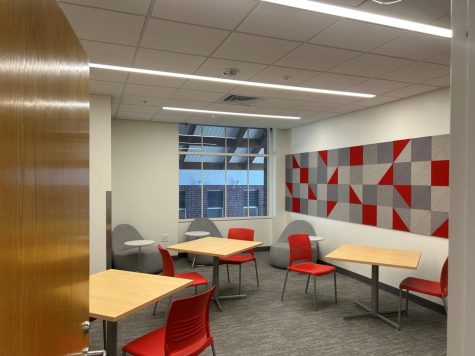
The new labs replaced the Carlson Science Library, an important resource for science students and faculty when it was built. But, as University Librarian Laura Robinson told The Scarlet, that model didn’t quite fit Clark’s 21st century needs.
“The model in what libraries provided in terms of our collections was primarily print-based, and now that’s just not the case,” she said. In addition, the Goddard Library had been working to shift more of its resources towards multidisciplinary research.
“To have smaller libraries on a smaller campus, I imagine that that could lead to silos we don’t want,” Robinson said. “We want all the disciplines partying together, right?”
Robinson joined Clark in 2020, but the university was considering closing the science library for over a decade. The decision made the most sense, Robinson explained, when Clark’s science librarian, Andy Dzaugis, retired.
“Andy was the science library,” Robinson explained. He knew the facility inside and out – and he knew how to close it properly, too, and how to ensure that the university still had access to scientific literature.
Still, much of the print material was saved and moved into the archives and upper stacks in the Goddard library, Robinson said.
After Dzaugis retired, the library did not hire a new science librarian. “At a small university like this, we don’t have subject specialists,” Robinson explained. Instead, she said, librarians “pool their expertise” to help students and faculty find the resources they need. “We work together and teach each other.”
“Overall, even though it’s hard to close something, it just seemed like it was going to create a lot of benefits,” Robinson said. “It was at the end of its lifecycle, in terms of what libraries handle.”
Frey, Williams and Abell all agreed that the change was for the best.
“It’s a really exciting time for my students in particular,” Frey said, “because they get an opportunity to be in this space and conduct their research.”
Her one message to Clark students: “join my lab!”

